Sports have played a vital role in creating a conciliatory mood on the divided peninsula with the two Koreas fielding unified teams and marching together under one flag at international sporting events. More recently, renewed efforts to build peace indicate that inter-Korean sports exchanges will likely gain new momentum.
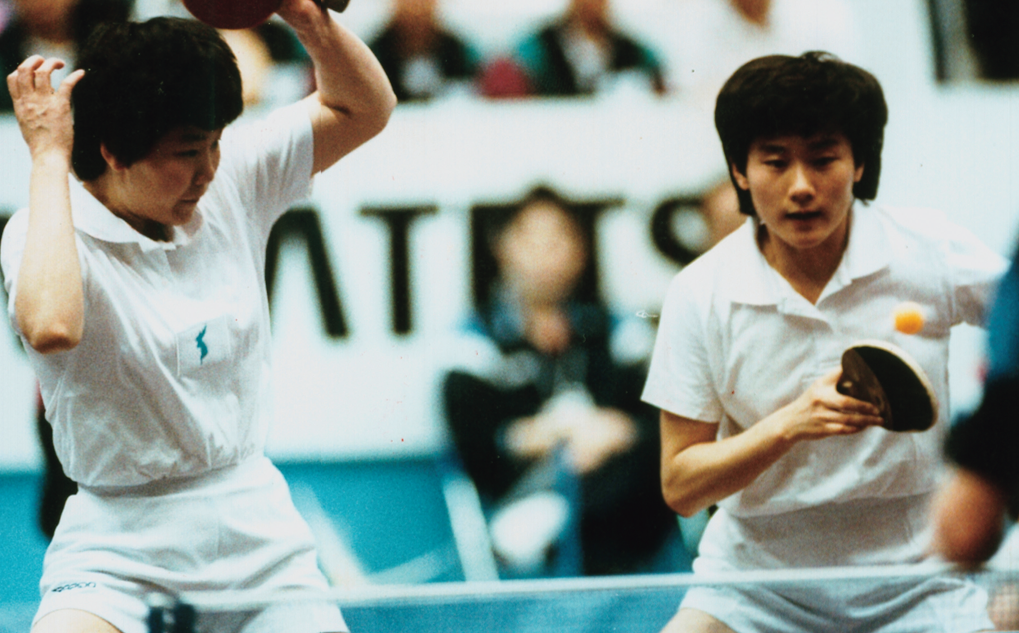
South Korean Hyun Jung-hwa (right) and North Korean Li Bun-hui play as a team at the 41st World Table Tennis Championships, held in April 1991 in Chiba, Japan. They defeated China 3:2 to win the women’s doubles event. It was the first international sports event since national division in which athletes from the two Koreas competed together.
In 1936, marathoner Sohn Kee-chung (1912-2002) ran at the 11th Summer Olympics in Berlin with the Japanese flag emblazoned on his uniform and won the gold medal. Born in Sinuiju, today’s North Korea, Sohn worked for a company based in Dandong, China when he was 16. Every day he would run the 20-plus li (approx. 8 km) across the Yalu River from Sinuiju to Dandong. Kim Yong-sik (1910-1985), a celebrated football player, coach and manager of South Korea’s national team, was born in Sinchon, Hwanghae Province in present-day North Korea. Both athletes came to Seoul around the same time and attended Bosung College, which is now Korea University.
National Division and War
The stories of the two sports heroes tell us that seven decades ago, traveling between the southern and northern regions of Korea was as natural as traveling between Birmingham and London, or Chicago and New York. However, this changed after territorial division and the outbreak of the Korean War in 1950.
At the turn of the 20th century, Korea was undergoing the first wave of industrialization and urbanization amid the influx of Western culture introduced through Japan. By 1897, a six-hole golf course had been built in Wonsan, a major port and industrial city along the east coast in what is now North Korea, and factories had their own football teams. In Incheon, a port city near Seoul, many sports clubs, including football, baseball, basketball and volleyball clubs, sprouted up as it developed into a modern industrial city.
Among the major cities in Korea, Pyongyang and Gyeong- seong (Seoul’s name during the colonial period) had the best teams and biggest fan bases. Pyongyang, which accepted Western culture early on through China and displayed continental influences, and Gyeongseong, which as the hub of Korea was abundant in human and material resources, became archrivals, especially in football. Matches between the two cities were dubbed “Gyeongpyong games.” These derbies, like any other between rival cities, were exciting events.
Up until 1946, right after the nation’s liberation from Japanese rule, home and away Gyeongpyong games and other regularly scheduled matches continued to be held. Exchanges between the two rival teams became more active with the transfer of Gyeongseong’s franchise player Kim Yong-sik to the Pyongyang team. If not for the ensuing national division and war, perhaps today we would still see player transfers between Seoul and Pyongyang, and avid fans traveling between the two cities to support their team in away games. Sadly, we have not seen such interactions for the past 70 years.
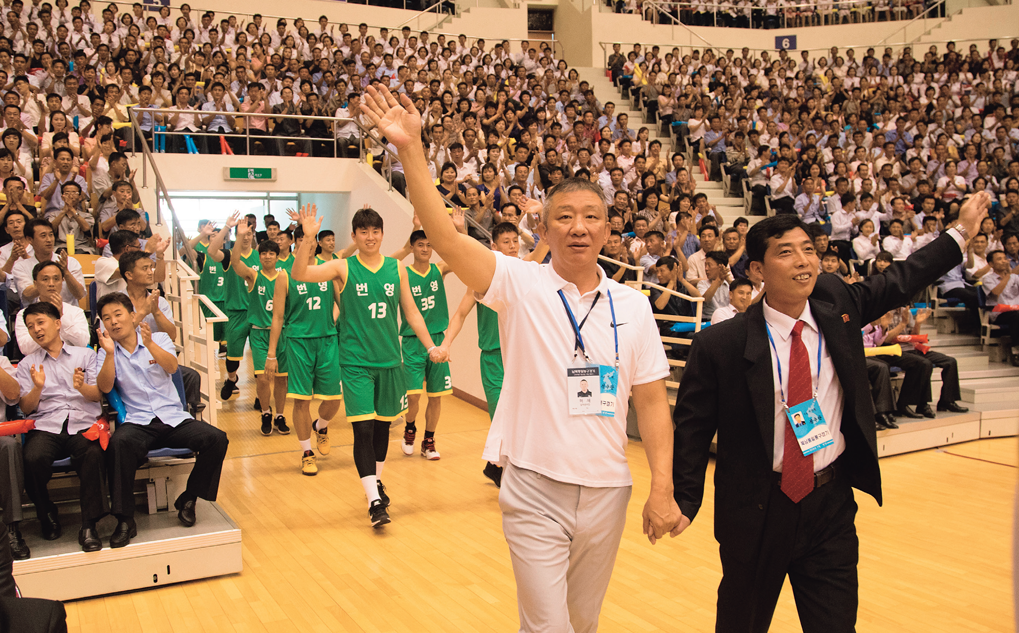
Basketball players and coaches from the two Koreas enter the Ryugyong Chung Ju-yung Gymnasium in Pyongyang for a game on July 4, 2018, one of four in two days. The series was the first basketball matchup between North and South Korea since 2003.
However, despite the ongoing political and military tensions on the peninsula, inter-Korean sports exchanges and cooperation have never completely ceased. Such exchanges first resumed in 1964, when at the request of the International Olympic Committee, the two sides met to discuss the formation of a unified team for the Summer Olympics in Tokyo, although the talks ended without substantive results. Inter-Korean talks on sports exchanges were conducted 13 more times until the late 1980s, but all to no avail.
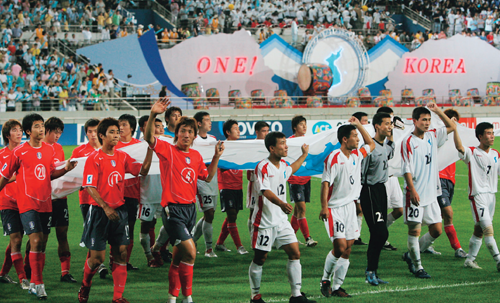
South and North Korean players circle the field holding the Unification Flag after a “unification football match” on September 7, 2002, at Seoul World Cup Stadium. The match, the first inter-Korean friendship competition since 1990, ended in a scoreless draw.
Competition and Cooperation
With progress stalled, the two Koreas competed against each other at several major sporting events. At the eighth FIFA World Cup held in England in 1966, the North Korean national team “Chollima,” its name derived from the mythical winged horse, stunned the world by advancing to the quarterfinals. At a time when sports were perceived as an extension of the political rivalry between the two Koreas, this unexpected feat provoked the South to set up a football club under the umbrella of the Central Intelligence Agency in 1967. Its sole goal was beating the North, not scoring a win in the World Cup or the Asian Cup. As most of the best players were in the military back then, the agency had no difficulty in recruiting talent from the army, marines and air force. The team received all-out support from the government. In 1969 alone, they spent 105 days in Europe for off-season training.
The manager of this football club during its overseas training was none other than the aforementioned Kim Yong-sik, the star player born in what is now North Korea. The club’s youngest striker was Lee Hoe-taik, who would serve as manager of the national team at the 14th World Cup in Italy in 1990. Lee visited Pyongyang for the “South-North unification match” held on October 11, 1990, as an advisor to the Southern team. There he was reunited with his father for the first time in 40 years, with the help of Park Doo-ik, the North Korean hero at the 1966 England World Cup. Having met at international matches, the pair had previously formed a friendship. Lee’s father went over to the North following the outbreak of the Korean War when Lee was just four years old. The day following the dramatic reunion was Lee’s birthday; his father prepared a birthday meal for him.
At international sporting events where the two Koreas met for a symbolic face-off, there have been a number of such incidences fraught with heartache and tears. At the 1964 Summer Olympics in Tokyo, Shin Keum-dan, a North Korean track-and-field athlete and world record holder in the women’s 400 and 800 meters, was reunited with her father, Shin Mun-jun, who was living in the South, after 14 years apart. The heartrending reunion lasted only a few minutes, arousing deep public sympathy. It even inspired a popular song.
At the 1978 Asian Games in Bangkok, the North and South Korean men’s football teams met in the grand final. The game went into overtime and ended in a goalless draw with the two sides sharing the gold. Yet a bitter scene unfolded at the medal ceremony. Kim Ho-kon, the South’s captain, allowed his Northern counterpart Kim Jong-min to go up on the podium ahead of him. But when Kim Ho-kon followed to take his place, the North’s captain refused to make room for him. The North’s goalie Kim Gwang-il even pushed him off when he tried to squeeze his way onto the podium.
During the 1960s and 1970s, the governments of both sides used not only sports but overall inter-Korean issues as a means to strengthen and prolong their dictatorial rule. The 1980s saw both sides competitively exhibiting the supremacy of their respective regimes, exploiting sports exchanges as a tool to manifest their legitimacy at home and abroad, as well as enhance their international images.
Despite the ongoing political and military tensions on the peninsula, inter-Korean sports exchanges and cooperation have never completely ceased.
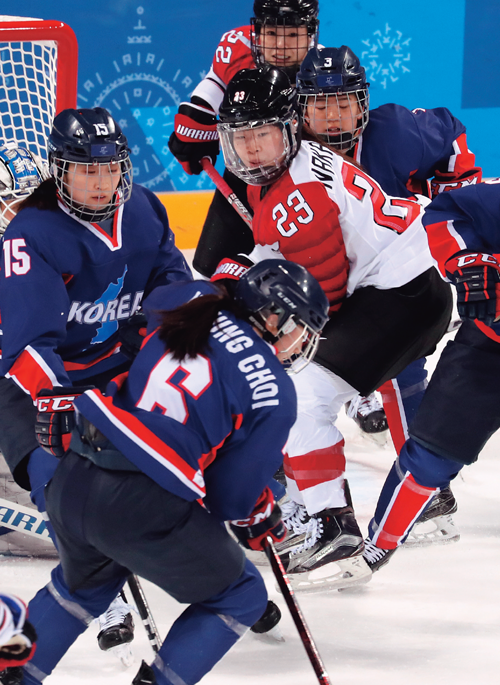
The two Koreas’ unified women’s hockey team plays at the 2018 PyeongChang Winter Olympics, drawing the world’s attention. Foreign news agencies commented the team, though defeated, “made history” and “achieved a victory for peace.”
Politics and Sports
Inter-Korean sports exchanges began to deliver tangible results in the 1990s. The Roh Tae-woo administration in the South launched the foreign policy initiative “Nordpolitik” in tandem with global post-Cold War trends, stressing inter-Korean exchange, especially in sports. In October 1990, the two Koreas held two “unification football matches,” one in Pyongyang and one in Seoul. The South’s midfielder Kim Joo-sung, who played in the match at the Rungrado 1st of May Stadium in Pyongyang, recalled the event in an interview, saying, “I was impressed by citizens of Pyongyang carrying us on their shoulders over some one kilometer from the Sunan International Airport. It was touching, though shocking.”
Such cross-border sports exchanges had a positive impact on inter-Korean relations. At the fifth high-level talks held on December 13, 1991, the two sides signed the “Agreement on Reconciliation, Non-Aggression, Exchanges and Cooperation between South and North Korea.” Also known as the “Inter-Korean Basic Agreement,” it was a landmark accord that continues to exert a positive influence on inter-Korean dialogue and negotiations to this day.
Building on the conciliatory mood, the two Koreas fielded a unified team at the 1991 World Table Tennis Championships held in Chiba, Japan. South Korea’s Hyun Jung-hwa and North Korea’s Li Bun-hui teamed up to defeat the defending champion China, led by Deng Yaping, 3 to 2 and win the gold medal in the women’s team event. The dramatic story of their victory was later made into a movie. In June the same year, the two Koreas formed a combined men’s football team for the FIFA World Youth Championship, held in Portugal, and advanced into the quarterfinals.
But sports exchanges between the two Koreas, just when they seemed to be taking off in earnest, came to a halt in the wake of Kim Il-sung’s death in 1994 and North Korea’s severe economic hardship.
Inter-Korean sports cooperation picked up again when South Korean President Kim Dae-jung and North Korean leader Kim Jong-il met for a historic summit in Pyongyang in June 2000, which resulted in the “June 15 South-North Joint Declaration.” On September 15 that year, athletes of the two Koreas paraded together for the first time at the opening ceremony of the Summer Olympics in Sydney. They did so again at the Busan Asian Games in 2002, the Aomori Asian Winter Games and the Daegu Summer Universiade in 2003, and the Athens Summer Olympics in 2004. In September 2002, the South and North Korean football teams held another “unification match” at the Seoul World Cup Stadium. After the game, Choi Tae-uk from the South and Ri Kang-in from the North exchanged their jerseys. Although FIFA advised against jersey-swapping, citing hygiene concerns, the two exchanged their boots as well as their jerseys as a symbolic gesture of “one nation.”
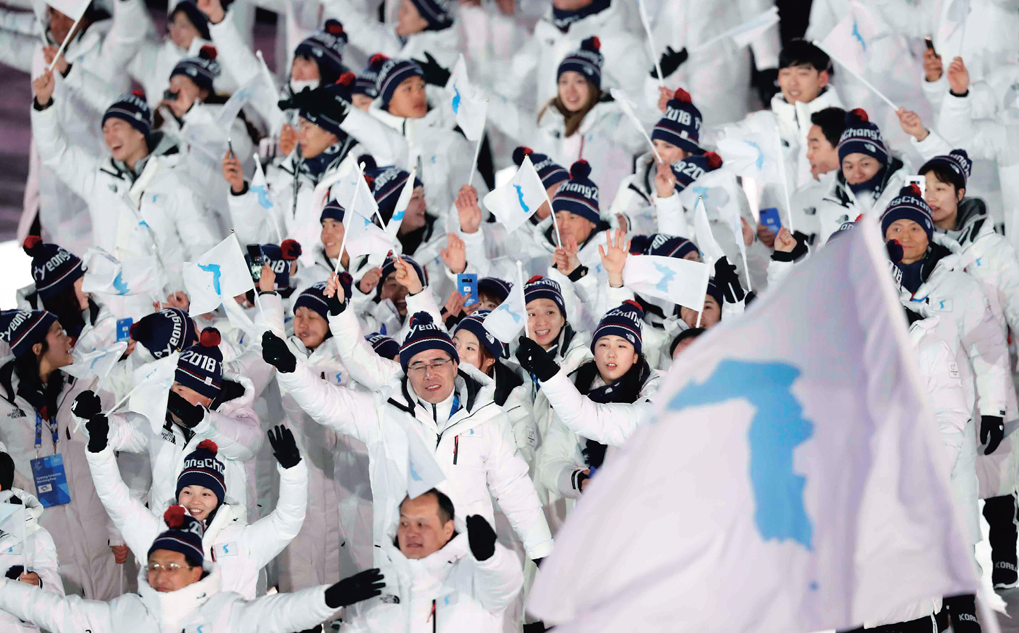
The two Koreas march together under the Unification Flag at the opening ceremony of the PyeongChang Winter Olympics on February 9, 2018. South Korea fielded 145 athletes in 15 disciplines, while North Korea sent 22 athletes in five disciplines.
Rekindled Hopes for Peace
Since 2011, North Korea has set out to transform itself into a sporting powerhouse, with a particular focus on football. Culture and sports have become top policy priorities as the regime pushes forward with its agenda of building a “civilized socialist state.” In 2015, Kim Jong-un traveled to the airport to welcome the women’s football team returning from the EAFF E-1 Football Championship and congratulate them on defending their title. He has also been zealously committed to building large-scale sports facilities, such as the Rungrado 1st of May Stadium, Yanggakdo Stadium, Pyongyang Golf Course, and Masikryong and Samjiyon ski resorts. At the Asian Cup and Inter-Club Weightlifting Championships held in Pyongyang in 2013, South Korea’s national flag was hoisted and its national anthem played for the first time on North Korean soil.
Policy shifts in North Korea under Kim Jong-un paved the way for members of its power elite to visit the South to attend the 2014 Asian Games in Incheon. The North also dispatched a large delegation of athletes and cheerleaders, as well as forming a joint women’s hockey team, to the PyeongChang Winter Olympics. On July 4 this year, the two Koreas held a friendly basketball game in Pyongyang. Talks are also underway to revive the Gyeongpyong football matches between the two capitals. Amid a growing mood for dialogue and efforts toward peace-building, cross-border exchanges in sports are expected to gain further momentum.
‘We Are One!’
In February this year, North Korea dispatched a squad of 229 cheerleaders to the PyeongChang Winter Olympics as part of its official delegation. With more than 10 times the number of the North’s 22 athletes, the all-female squad cheered for both Koreas. Ahead of the Olympics, the North sent a troupe of some 140 top-class musicians, singers and dancers to stage two performances in Seoul and Gangneung.
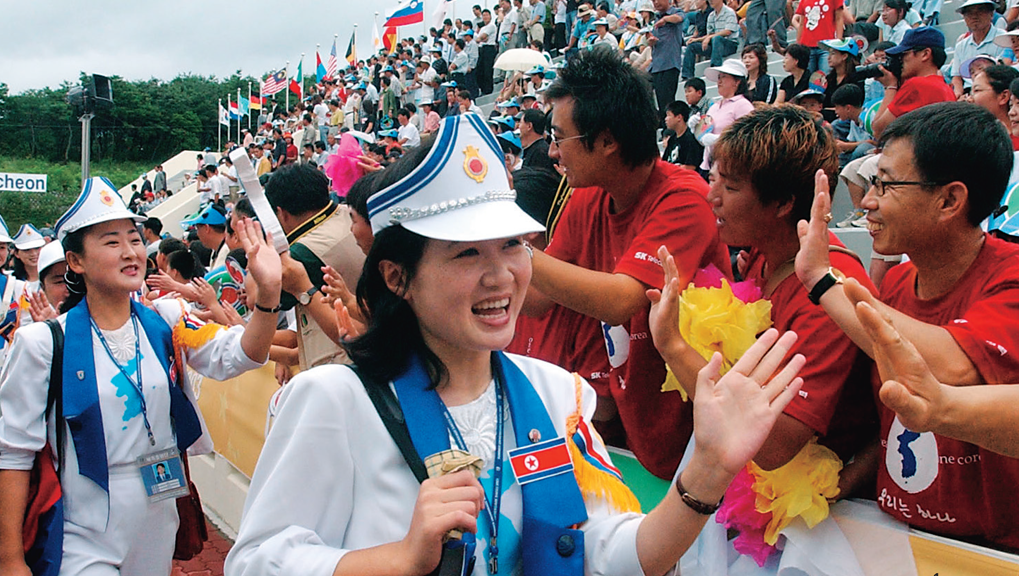
South Korean spectators welcome the North Korean cheerleading squad at the PyeongChang Winter Olympics. The cheerleaders attracted big crowds both inside and outside the Olympic venues.
North Korean cheerleaders grab the global spotlight as much for their looks as for the volatile situation on the peninsula and the enigmatic nature of the regime in Pyongyang. As a key component of the North’s “charm offensive,” they can serve to ease tension and deliver a public display of peace.
As expected, North Korea’s formidable team of cheerleaders at the PyeongChang Winter Olympics received enormous attention not only within South Korea but worldwide as well. The cheerleaders attracted huge crowds everywhere they went, be it sports arenas or tourist spots; their every move was covered by the media.
Fourth Visit
Of course, North Korea has previously sent cheerleaders to major sporting events hosted in Asia; this is the fourth time the North’s cheer squad has traveled to South Korea, following the 2002 Asian Games in Busan, the 2003 Summer Universiade in Daegu and the 2005 Asian Athletics Championships in Incheon.
The dispatch of cheer squads to overseas sporting events is also of major interest in North Korea. The members are given the rare opportunity to travel overseas and, at times, the chance to move up the social ladder. So it comes as no surprise that competition for a spot on the team is fierce. Members are selected largely from students in performing arts schools in Pyongyang based on strict criteria including appearance, family background and loyalty. It was rumored that the dispatch of cheerleaders to the 2014 Incheon Asian Games was cancelled due to excessive competition to join the squad.
There is a common saying in Korea, namnam bugnyeo. It means, “Men from southern regions are more handsome and women from northern regions are more beautiful.” Perhaps that’s why the frenzy surrounding the North Korean cheerleaders has at times catapulted certain members to stardom. Ri Yu-gyong, captain of the cheering team that came in 2002, and the youngest member Chae Bong-i enjoyed immense popularity and even had their own online fan clubs. Team member Cho Myong-ae even starred in a TV commercial with South Korean pop star Lee Hyori.
Ri Sol-ju, the first lady of North Korea, has received the greatest spotlight of any of the former cheerleaders. When she first visited the South for an inter-Korean Red Cross youth event in 2003, people raved about her beauty. Thereafter, she attended the North-South meeting of teachers at Mt. Kumgang in 2004 and was included as a member of the cheerleading team for the 2005 Asian Athletics Championships. At the time, Ri said in an interview, “My dream is to perform in an arts troupe.” She went on to join the Moranbong Band and later married Kim Jong-un, reportedly around 2011-2012.
Not all the buzz surrounding the North Korean cheerleaders has been positive. There was one incident during the 2003 Summer Universiade concerning a banner with the image of Kim Jong-il’s face. While they were traveling on a bus, the cheer squad saw the banner of their “dear leader” getting wet in the rain. They burst into tears and cried, “Our great general’s face is getting wet. We cannot leave it like this.” The banner had to be removed immediately.
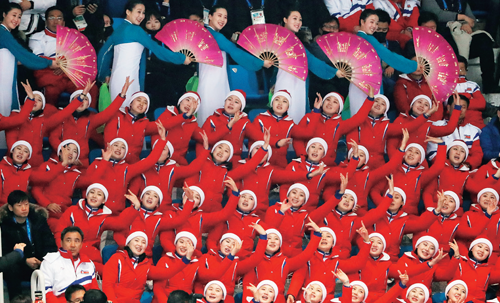
North Korean cheerleaders sing and shout encouragement at a women’s track event. They drew attention with perfectly synchronized movements and cheers.
Popularity and Controversy
At the start of the PyeongChang Winter Olympics, the North Korean cheerleading team unwittingly landed themselves in controversy over their use of so-called “Kim Il-sung face masks.” The masks were used as props while cheering to a North Korean pop song, inviting heavy criticism from South Korean conservative groups. They contended that the masks resembling the face of the young Kim Il-sung were being used for propaganda. Both the South Korean government and North Korean officials denied the allegation, saying that the image was of a handsome man, most probably a famous North Korean actor. They said that North Koreans would not dare to make a mask bearing the image of their “supreme leader,” and most certainly would not pierce holes into it.
Prior to this, at a warm-up match of the inter-Korean women’s ice hockey team there was an issue concerning the Korean peninsula flag showing Dokdo, a group of islets that has been a point of ongoing contention between Korea and Japan. At the protest of the Japanese government, the IOC urged that Dokdo be removed from the flag at the Winter Olympics. South Korea complied, and at the opening ceremony, athletes from the two Koreas marched behind the Unification Flag without the islets. However, the North protested and, throughout the games, the cheerleaders waved the Unification Flag showing Dokdo along with their national flag.
In the past, the visit of a North Korean cheerleading team was in itself big news. During their first visit in 2002, thousands flocked to the harbor to see the passenger ferry where the cheer squad was staying. On their latest visit, the first in 13 years, the North Korean cheerleading team was again the center of attention at every event they attended. They cheered and danced in perfect synchronization, shouting slogans such as “We are one!” and “Let us unite!” and singing folk songs familiar to people from both sides. However, they seemed utterly uninterested when South Korean pop music filled the arena. Likewise, they were completely indifferent when other countries were competing, and left the stadium immediately after matches involving the Korean teams were over.
South Korean spectators also showed somewhat different reactions compared to the past. Some commented that the North Korean cheerleaders seemed like “an isolated island” or “machines” and that they appeared to be “trapped in their own little world.” The North’s nuclear provocations that continued up until a few months before the Olympics and controversy surrounding the last-minute formation of a unified women’s hockey team had evidently soured public sentiment.